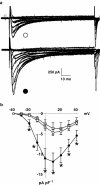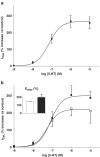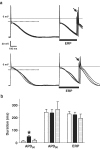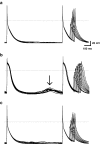Electrophysiological effects of 5-hydroxytryptamine on isolated human atrial myocytes, and the influence of chronic beta-adrenoceptor blockade
- PMID: 14623763
- PMCID: PMC1574154
- DOI: 10.1038/sj.bjp.0705553
Electrophysiological effects of 5-hydroxytryptamine on isolated human atrial myocytes, and the influence of chronic beta-adrenoceptor blockade
Abstract
5-Hydroxytryptamine (5-HT) has been postulated to play a proarrhythmic role in the human atria via stimulation of 5-HT4 receptors. The aims of this study were to examine the effects of 5-HT on the L-type Ca2+ current (ICaL) action potential duration (APD), the effective refractory period (ERP) and arrhythmic activity in human atrial cells, and to assess the effects of prior treatment with beta-adrenoceptor antagonists. Isolated myocytes, from the right atrial appendage of 27 consenting patients undergoing cardiac surgery who were in sinus rhythm, were studied using the whole-cell perforated patch-clamp technique at 37 degrees C. 5-HT (1 nm-10 microm) caused a concentration-dependent increase in ICaL, which was potentiated in cells from beta-blocked (maximum response to 5-HT, Emax=299+/-12% increase above control) compared to non-beta-blocked patients (Emax=220+/-6%, P<0.05), but with no change in either the potency (log EC50: -7.09+/-0.07 vs -7.26+/-0.06) or Hill coefficient (nH: 1.5+/-0.6 vs 1.5+/-0.3) of the 5-HT concentration-response curve. 5-HT (10 microm) produced a greater increase in the APD at 50% repolarisation (APD50) in cells from beta-blocked patients (of 37+/-10 ms, i.e. 589+/-197%) vs non-beta-blocked patients (of 10+/-4 ms, i.e. 157+/-54%; P<0.05). Both the APD90 and the ERP were unaffected by 5-HT. Arrhythmic activity was observed in response to 5-HT in five of 17 cells (29%) studied from beta-blocked, compared to zero of 16 cells from the non-beta-blocked patients (P<0.05). In summary, the 5-HT-induced increase in calcium current was associated with a prolonged early plateau phase of repolarisation, but not late repolarisation or refractoriness, and the enhancement of these effects by chronic beta-adrenoceptor blockade was associated with arrhythmic potential.
Figures






References
-
- BERS D.M. Cardiac excitation–contraction coupling. Nature. 2002;415:198–205. - PubMed
-
- BLONDEL O., VANDECASTEELE G., GASTINEAU M., LECLERC S., DAHMOUNE Y., LANGLOIS M., FISCHMEISTER R. Molecular and functional characterization of a 5-HT4 receptor cloned from human atrium. FEBS Lett. 1997;412:465–474. - PubMed
-
- DAWODU A.A., MONTI F., IWASHIRO K., SCHIARITI M., CHIAVARELLI R., PUDDU P.E. The shape of human atrial action potential accounts for different frequency-related changes in vitro. Int. J. Cardiol. 1996;54:237–249. - PubMed
-
- GRAMMER J.B., ZENG X., BOSCH R.F., KUHLKAMP V. Atrial L-type Ca2+-channel, β-adrenoreceptor, and 5-hydroxytryptamine type 4 receptor mRNAs in human atrial fibrillation. Basic Res. Cardiol. 2001;96:82–90. - PubMed
-
- GRIMM M., GSELL S., MITTMANN C., NOSE M., SCHOLZ H., WEIL J., ESCHENHAGEN T. Inactivation of Giα proteins increases arrhythmogenic effects of β-adrenergic stimulation in the heart. J. Mol. Cell. Cardiol. 1998;30:1917–1928. - PubMed
Publication types
MeSH terms
Substances
LinkOut - more resources
Full Text Sources
Miscellaneous

